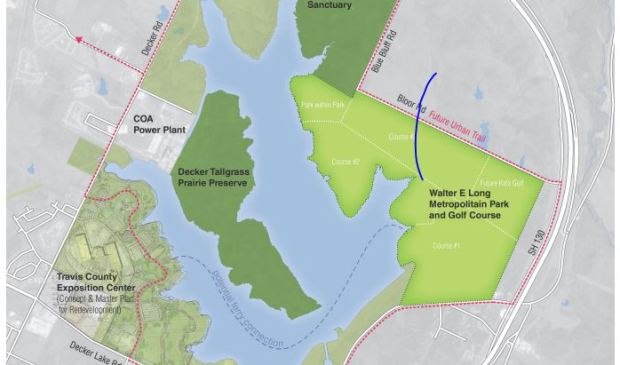Golf, recreation areas considered for future of Walter Long Park
Tuesday, October 30, 2018 by
Chad Swiatecki Golf course, or no golf course?
There are other questions being discussed with community members in and around East Austin about the future of Walter E. Long Metropolitan Park, but one of the main questions is whether the 3,695-acre park should have a golf course added as the city looks for ways to improve the property in the coming years.
The Parks and Recreation Department has completed three public input sessions, with a final one expected to be held in early December, to gather feedback that will be used to create a master plan for the park that is several times larger than Zilker Park and has been mostly unimproved since the 1970s.
While some proposals for the park have suggested draining some of the 1,200-acre lake to create more recreation areas, feedback from the early community input sessions has favored keeping the lake at its current level and incorporating a mix of passive, active and natural recreation areas. Those sessions have also shown that more than 60 percent of respondents both from close to the park and those farther away consider adding a golf course “not at all important” to the park’s future use, though proponents argue the course would provide some of the revenue needed to improve and maintain the rest of the grounds.
After the final input session in December, PARD will use the feedback to prepare the master plan that will likely be taken to relevant commissions and City Council for adoption early next year. From there, staff will start the necessary requests for qualifications or proposals to carry out the planned improvements.
Walter E. Long Park has been a jewel in the rough for golf enthusiasts for many years. In 2015, a group led by former Professional Golfers’ Association pro golfer Joe Ogilvie and nearby landowner Warren Hayes was pushing a plan to spend $25 million to convert 700 acres of the park into a professional-grade course.
The attraction for golf proposals there comes from the increasing amounts of development headed east in recent years – including the city of Austin’s own Colony Park mixed-use development – and the uncertain fate of Lions Municipal Golf Course in Central Austin that could steer demand for the sport eastward.
But in 2016 City Council voted to forward the golf question to a pair of city commissions for evaluation, despite the support of Council Member Ora Houston, who has been a strong supporter of a golf course on the park that is located in her district.
“The constituents are still for a professional golf course so that there is revenue generation to re-invest in the park. I have always supported the right of the constituents in District #1 to determine what they feel is best for their community,” Houston said by email Monday. “I’m excited for the possibilities for both recreation and leisure uses, as well as for some economic development uses and benefit for the community.”
Houston is not seeking re-election for her City Council seat, and the use of the park has not been a central issue among the candidates running to fill the District 1 seat in January.
Also playing a possible role in the park’s future is an expected renovation of the Travis County Expo Center that is located on the park property, with the buildings owned and managed by the county on the city’s land through a lease that expires in 2033.
On Thursday, City Council will consider a resolution directing the city manager to research and present options to for the “redevelopment, renovation, and activation” of the expo center.
PARD staff said the early community meetings saw many residents surprised at the size of the park and the possibilities it offers for the growing population in the area.
“At the beginning of the process many of the people were not aware of the significant size of the park, or even that it actually was a park the city owned … just that it was a place where they would go to see the rodeo or car shows,” said Gregory Montes, park development coordinator for PARD.
Montes acknowledged the role the park has played as a sort of theoretical far-off “catchall” as a possible location for large festivals and other events that draw noise and traffic complaints from residents closer to the city center.
“There were folks who felt the park has an opportunity to become a catchall, where you put things that are seen as a nuisance as far as the traffic or noise they bring,” he said.
“That went as far as the Special Events Task Force saying it could be a possible destination for festivals impacting other city parks, but there’s also so many unique features out there that you don’t see in other parks. There are a lot of people who want to preserve those, so we’re trying to find a balance.”
This story has been corrected. We originally reported that public sessions showed that more than 60 percent of respondents supported adding a golf course that would provide some of the revenue needed to improve and maintain the rest of the grounds. In fact, more than 60 percent of respondents said golf at that location was “not important at all.”
Map courtesy of the city of Austin.
The Austin Monitor’s work is made possible by donations from the community. Though our reporting covers donors from time to time, we are careful to keep business and editorial efforts separate while maintaining transparency. A complete list of donors is available here, and our code of ethics is explained here.
You're a community leader
And we’re honored you look to us for serious, in-depth news. You know a strong community needs local and dedicated watchdog reporting. We’re here for you and that won’t change. Now will you take the powerful next step and support our nonprofit news organization?










